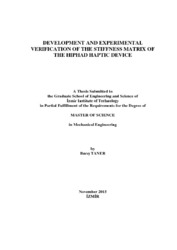Please use this identifier to cite or link to this item:
https://hdl.handle.net/11147/4545| Title: | Development and Experimental Verification of the Stiffness Matrix of the Hiphad Haptic Device | Other Titles: | Hıphad Haptik Cihazının Direngenlik Matrisinin Oluşturulması ve Deneysel Olarak Doğrulanması | Authors: | Taner, Barış | Advisors: | Dede, Mehmet İsmet Can | Keywords: | Virtual joint method Structural matrix analysis Stiffness Experimental Stiffness Analysis Haptics HIPHAD |
Publisher: | Izmir Institute of Technology | Source: | Taner, B. (2015). Development and experimental verification of the stiffness matrix of the HIPHAD haptic device. Unpublished master's thesis, Izmir Institute of Technology, Izmir, Turkey | Abstract: | In this work the evaluation of stiffness performance of HIPHAD haptic device has been studied with 2 semi-analytical and an experimental method in order to obtain the stiffness characteristics of the haptic device for precise motion tracking performance. Since the compliance of a robot depends highly on robot configuration and force is variable in the haptic applications, stiffness properties of main robot elements and methods of evaluating stiffness of a robot manipulator is investigated considering the computational costs. Virtual Joint Method (VJM) and Structural Matrix Analysis (SMA) method is applied to the case study. Although, structural matrix analysis reduces the computational time dramatically by reducing the node elements it is not accurate as Finite Element Analysis (FEA) method. Comparing the VJM to the SMA, it is applicable to online application due to its simplicity and flexibility. In addition, with FEA based link modelling VJM is as accurate as FEA method in finding stiffness of the manipulator. While both methods can include flexible joints FEA based link stiffness parameters computational costs for these methods is the performance criteria for choosing one. For the case study HIPHAD, the VJM method provides better result in terms of flexibility and computation cost with 0.035 seconds finding the resultant force while SMA method calculates result in 0.074 seconds. Bu çalışmada, HIPHAD haptic cihazının direngenlik karakteristiği, hassas hareket takibi sağlayabilmesi için, iki yarı analitik ve bir de deneysel yöntem ile bulunmuştur. Haptik uygulamalarda kuvvetin büyüklüğü ve yönü değişken olduğundan ayrıca robotların direngenlik matrislerinin mafsal açılarına bağlı olarak değişiklik göstermesinden dolayı, robot kollarının direngenlik matrisinin çıkarılmasında kullanılan metotlar gerektirdikleri hesaplama zamanı düşünülerek araştırılmıştır. Bu tezde Sanal Mafsal Metodu ve Yapısal Matris Analizi yöntemleri kullanılmıştır. Yapısal Matris Analizi metodu her ne kadar hesaplama zamanını azaltıyor olsa da modelin doğruluğu azalmaktadır. Sanal mafsal metodu ve yapısal matris analizi kıyaslandığında, sanal mafsal metodu daha esnek ve basit bir modelleme yöntemi sunmaktadır. Bunun yanı sıra sonlu elemanlar analizi kullanılarak bulunan direngenlik değerleri sayesinde bu yöntem, sonlu elemanlar analizi kadar isabetli sonuçlar verebilmektedir. Yapısal matris analizi de sanal mafsal metodu da esnek mafsal modellerinde bulundurabilir. Dolayısı ile bu iki metot arasındaki belirleyici fark hesaplama zamanlarından gelecektir. HIPHAD için VJM metodu daha doğru sonuçlar vermiştir. Yapısal matris analizi metodu ve sanal mafsal motodu için bir döngünün çözüm süres 0.074 sn ve 0.035 olarak ölçülmüştür. |
Description: | Thesis (Master)--Izmir Institute of Technology, Mechanical Engineering, Izmir, 2015 Includes bibliographical references (leaves: 148-152) Text in English; Abstract: Turkish and English xvi, 152 leaves |
URI: | http://hdl.handle.net/11147/4545 |
| Appears in Collections: | Master Degree / Yüksek Lisans Tezleri |
Files in This Item:
| File | Description | Size | Format | |
|---|---|---|---|---|
| T001408.pdf | MasterThesis | 4.33 MB | Adobe PDF |  View/Open |
CORE Recommender
Page view(s)
260
checked on Mar 31, 2025
Download(s)
104
checked on Mar 31, 2025
Google ScholarTM
Check
Items in GCRIS Repository are protected by copyright, with all rights reserved, unless otherwise indicated.